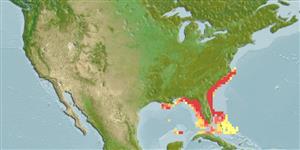>
Clupeiformes (Herrings) >
Alosidae (Shads and Sardines)
Etymology: Brevoortia: From James Carson Brevoort (1818-1887), studie the fauna from Ohio and South Caroline (Ref. 45335).
More on author: Hildebrand.
Environment: milieu / climate zone / depth range / distribution range
Ecologia
marino; salmastro; distribuzione batimetrica 0 - 50 m (Ref. 188). Subtropical; 37°N - 23°N, 92°W - 74°W (Ref. 188)
Western Central Atlantic: Beaufort, North Carolina, to Indian River, Florida; Gulf of Mexico (Florida Bay to Louisiana, with possible break between Biscayne Bay and Florida Bay) (Ref. 188). Hybridize with B. tyrannus and B. patronus (Ref. 84218).
Size / Peso / Age
Maturity: Lm ? range ? - ? cm
Max length : 33.0 cm SL maschio/sesso non determinato; (Ref. 37032); common length : 20.0 cm SL maschio/sesso non determinato; (Ref. 188)
Spine dorsali (totale): 0; Spine anali 0. Scutes apparent along belly; upper jaw with median notch. Pelvic fin with oblique and almost straight hind margin, the inner fin rays markedly shorter than outer fin rays when fin folded back. Pre-dorsal scales modified; scales in lateral series small and numerous, those on back and above anal fin markedly smaller than rest. A black spot behind gill opening, but none along flank (Ref. 188). Silvery, with a greenish or bluish back. Fins golden yellow (Ref. 7251).
A schooling species (but perhaps not in the northern part of its range) occurring inshore and in bays and estuaries. Feeds by filtering phytoplankton. Breeds in winter, probably November through to February or March. Eggs and larvae are planktonic (Ref. 188). Parasitic copepod found in the stomach (Ref. 37032).
Life cycle and mating behavior
Maturità | Riproduzione | Deposizione | Uova | Fecundity | Larve
Breeds in winter (eggs and larvae in plankton), probably November through to February or March (no data from Gulf of Mexico).
Whitehead, P.J.P., 1985. FAO Species Catalogue. Vol. 7. Clupeoid fishes of the world (suborder Clupeoidei). An annotated and illustrated catalogue of the herrings, sardines, pilchards, sprats, shads, anchovies and wolf-herrings. FAO Fish. Synop. 125(7/1):1-303. Rome: FAO. (Ref. 188)
IUCN Red List Status (Ref. 130435)
Threat to humans
Harmless
Human uses
Pesca: scarso interesse commerciale
Informazioni ulteriori
BibliografiaAcquacolturaProfilo di acquacolturaVarietàGeneticaElectrophoresesEreditarietàMalattieElaborazioneNutrientsMass conversion
CollaboratoriImmaginiStamps, Coins Misc.SuoniCiguateraVelocitàModalità di nuotoArea branchialeOtolithsCervelliVista
Strumenti
Special reports
Download XML
Fonti Internet
Estimates based on models
Preferred temperature (Ref.
123201): 22.9 - 26.7, mean 24.4 °C (based on 126 cells).
Phylogenetic diversity index (Ref.
82804): PD
50 = 0.5156 [Uniqueness, from 0.5 = low to 2.0 = high].
Bayesian length-weight: a=0.00912 (0.00387 - 0.02150), b=3.06 (2.88 - 3.24), in cm total length, based on LWR estimates for this Genus-body shape (Ref.
93245).
Trophic level (Ref.
69278): 2.3 ±0.00 se; based on food items.
Resilienza (Ref.
120179): Medio, tempo minimo di raddoppiamento della popolazione 1.4 - 4.4 anni (Preliminary K or Fecundity.).
Fishing Vulnerability (Ref.
59153): Low to moderate vulnerability (30 of 100).
Nutrients (Ref.
124155): Calcium = 112 [64, 193] mg/100g; Iron = 1.6 [0.9, 2.7] mg/100g; Protein = 19.5 [18.3, 20.5] %; Omega3 = 0.547 [0.334, 0.873] g/100g; Selenium = 20.1 [10.7, 37.6] μg/100g; VitaminA = 10.4 [4.1, 25.4] μg/100g; Zinc = 1.33 [0.93, 1.88] mg/100g (wet weight);
